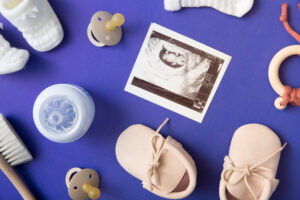Infants start cutting their primary teeth (also known as baby teeth) around 6 months. The first two to pop through are usually the bottom central incisors.
Parents often notice increased drooling, crankiness, and the need to chew on things during this time. It is also common for sleeping schedules to get off track.
Stage 1: 4-6 Months
At birth, infants already have a full set of 20 primary teeth located in their jawbones beneath the gums. These are also referred to as “milk teeth” because babies’ diets typically consist of milk alone during this stage.
Teething is different for every baby, but there are recognizable symptoms parents can watch out for during this period of time. Most of the time, teething will cause your infant to be irritable and sleepless during the day. Infants may also experience drooling, as well as the desire to chew on things like their fingers or toys.
The first teeth to erupt are usually the two bottom front teeth (central incisors), followed 4 to 8 weeks later by the four upper front teeth (central and lateral incisors). These baby teeth are thinner and have a knifelike finish, making them easier to slip through the gums than the molars that will come in around the same age.
This is a common time for infants to begin losing their baby teeth, but this is normal and nothing to worry about. You can help ease your child’s discomfort by gently massaging their gums with a clean finger or knuckle, and offering them chilled teething rings, cloths, or spoons to chew on. It is also typical for infants to lose their appetite and start sleeping less at night during this phase.
Stage 2: 6-8 Months
During the second stage of teething, infants experience some discomfort. They might be irritable during the day and sleepless at night. Fortunately, there are some ways to ease their discomfort.
The first baby teeth usually appear during this time. The two bottom front teeth (central incisors) start to come in first, followed by the four upper front teeth about a month later.
Some babies get their first tooth a little bit earlier or later than other children, but that doesn’t mean anything is wrong. It’s just a matter of genetics.
Parents will notice a significant increase in drool, crankiness, and the desire to chew on solid objects during this period. A loss of appetite is also common. This is a great time to try frozen fruits and vegetables for babies to chew on. Just make sure the object is firm and not too cold or too soft, which could cause choking.
At this point, teething symptoms will be more consistent than before, and the drooling is probably noticeable to others as well. The teeth (between the incisors and molars on both top and bottom) called canines will appear during this stage as well. Parents may need to use the same techniques to comfort their baby and keep them comfortable. In fact, the canine teeth tend to be the most painful for some children, so it’s important that you’re prepared with different soothing methods.
Stage 3: 8-12 Months
At this stage, a baby will experience the pain and discomfort of their largest teeth, the molars. These are the primary teeth and will eventually fall out to be replaced with permanent adult teeth. This is a difficult time for most babies and parents. But understanding what is happening can help.
When a child is born, they have a complete set of 20 primary teeth underneath their gums. They are commonly referred to as milk teeth and can start to erupt as early as four to seven months. The first teeth to appear are the two central incisors (upper or lower), then the other teeth will appear over the next few months.
During this stage, a child will experience the same symptoms as in stage 2 including drooling, crankiness and a desire to chew on hard objects. It is also normal for babies to lose sleep at night during this period.
This is the last phase and can be the most painful, especially for toddlers. It is a good idea to use old tricks from previous stages to comfort the child. One suggestion is to offer a frozen carrot for the child to chew on, which can decrease discomfort and be very satisfying for them. However, be sure to watch the child closely at all times to avoid choking.
Stage 4: 12-18 Months
At this stage, the infant’s primary molars start to erupt. They are located in the back of the lower and upper jaw. This is the most painful teething stage for babies and is typically accompanied by increased fussiness, drooling, and a desire to chew on hard objects. It is also common for the baby to lose their appetite during this time and have difficulty sleeping at night.
While some kids’ first teeth appear earlier than this, most children’s first two bottom central incisors usually erupt between 6 and 9 months of age. They are followed about a month later by the four front upper central incisors, and then the lateral incisors. It is also rare for an infant to be born with one or more teeth, but these teeth can cause problems if they are in the wrong position and interfere with eating and chewing.
This is a difficult stage for parents because they are often unable to soothe their fussy babies with the usual methods they used in stages 2 and 3. Some parents have found that giving their child chilled (but not frozen) teething toys, rings or cloths to chew on can provide some relief from the pain. They can also try applying pressure to the gums or providing them with a hard object like a raw carrot or cucumber that has been chilled for a few minutes.





